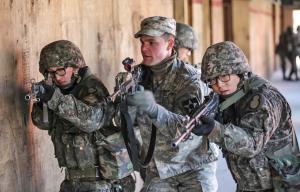Brown warns: ‘We have to be ready to fight tonight’ in Pacific
Brown warns: ‘We have to be ready to fight tonight’ in Pacific
The U.S Army must be ready to fight at any time in the largest, and arguably the most complex, region of the world, Gen. Robert Brown said during the Association of the U.S Army’s Annual Meeting and Exposition.
Brown, the commanding general of U.S. Army Pacific, oversees 94,000 soldiers and 12,000 civilians in an area that encompasses 52 percent of the world’s surface.
“We have to be ready to fight tonight,” Brown said.
Adding, “Kim Jong Un is more aggressive than anyone could have imagined, especially considering he is the only person in the 21st century to conduct a nuclear missile test.”
North Korea, China, and Russia all lie within his domain, and violent extremist organizations are moving into the pacific AOR as well, Brown said.
“We must set the path to multi-domain battle,” he said, and that means providing multiple dilemmas to enemies and multiple options for commanders.
Readiness at the tactical, operational and strategic level is particularly important considering the vast distances involved, he said, pointing to the Pacific Pathways exercises as a key readiness builder.
Under Pacific Pathways, the Army sends units to be forward-deployed on location to train with the militaries of allied and partner nations in response to humanitarian emergencies or military crises.
“Pacific Pathways enhances unit readiness at echelon, because it involves so many different formations and joint organizations,” said Lt. Gen. Stephen Lanza, commanding general, I Corps and Joint Base Lewis-McChord.
At the strategic level, Lanza stressed that having forward-deployed units helps to reassure our partners and allies.
“Having that forward presence there during an operation is extremely important, and it opens the aperture to access” in case of a real problem, he said.
Additionally, Lanza said, “the ability to execute our power projection platforms for a readiness exercise” is very significant.
Operationally, each country involved has a particular specialty in which they are very skilled.
“For example, in Singapore, they have a tremendous training center to conduct urban operations. In Indonesia, they want to train on battalion live-fire and integrating maneuver and aviation capabilities. In Malaysia, they do jungle operations and air assault. We take all those capabilities and leverage them with our own, which enhances readiness,” Lanza said.
On the tactical level, units from squad-size to company-size conduct combined arms live-fire exercises, under different conditions and in different locations. “We’re making the training additive, and getting more repetitions,” Lanza said.


